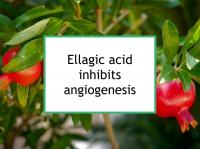Tumors must induce angiogenesis in order to grow beyond a very small size. Blocking this step is one strategy for fighting cancer. Ellagic acid, a flavonoid found in numerous berries, pomegranates and other foods, has been shown to inhibit breast cancer in cell and animal studies. Now a new study has described how ellagic acid inhibits angiogenesis.
Angiogenesis is required for tumor growth
Breast cancer tumors cannot develop beyond an insignificant size without the development of new blood vessels. Cancer cells induce angiogenesis during the early stages of tumor development — this is a crucial step that separates preinvasive and dormant forms of cancer from invasive and metastatic growth. A number of fruit and vegetable compounds have been found to have anti-angiogenic properties, among them ellagic acid.
Fruits with ellagic acid are linked to reduced breast cancer risk
The most abundant dietary sources of ellagic acid are boysenberries, blackberries, raspberries, and pomegranates. Ellagic acid is also found in strawberries, currants, muscadine grapes, blueberries, cranberries, walnuts, and pecans. Numerous studies have reported that ellagic acid and the fruits that contain substantial amounts of it have chemopreventive properties:
- A study using a rat model of breast cancer found that ellagic acid delayed the first tumor appearance by three weeks when it was given in the diet. The tumor incidence was 69% in the treatment group, whereas 100% of the control rats that did not receive ellagic acid had palpable tumors by week 26.
- A study designed to investigate differences in how blueberries and black raspberries prevent breast cancer found that rats fed either berry had significantly reduced numbers and volumes of mammary tumors compared to rats not given a berry diet. While blueberry resulted in lower tumor volume than black raspberry, black raspberry was more effective in delaying the first tumor incidence, by five weeks. While blueberry contains five different anthocyanidins (delphinidin, cyanidin, malvidin, peonidin, and petunidin) and small levels of ellagic acid, black raspberry contains primarily the anthocyanidin cyanidin and high levels of ellagic acid. The distinct and specific molecular targets and pathways involved in the protective actions of the two berries are derived from their distinct phytochemical signatures.
- A study designed to test the anti-breast cancer activities of pomegranate ellagitannin-derived compounds (including ellagic acid, gallagic acid, urolithin A, and urolithin B, as well as the urolithins' acetylated, methylated, and sulfated analogues) reported that six of them inhibited aromatase activity (in which androgens are converted to estrogens in the body by the aromatase enzyme), thereby interfering with a process that plays a key role in breast carcinogenesis.
- A Canadian study evaluated the chemopreventive activities of edible berries cultivated or collected in the province of Québec, including strawberry, raspberry, black currant, red currant, white currant, gooseberry, high-bush blueberry, low-bush blueberry, velvet leaf blueberry, serviceberry, blackberry, black chokeberry, sea buckthorn and cranberry. The growth of various cancer cell lines, including breast cancer, was found to be strongly inhibited by raspberry, black currant, white currant, gooseberry, velvet leaf blueberry, low-bush blueberry, sea buckthorn and cranberry juice, but not (or only slightly) by strawberry, high-bush blueberry, serviceberry, red currant, or blackberry juice. No correlation was found between the antiproliferative activity of berry juices and their antioxidant capacity. The inhibition of cancer cell proliferation by berry juices appeared to involve cell-cycle arrest.
- Five types of caneberries (blackberries, marionberries, boysenberries, red raspberries, and black raspberries) were analyzed for antioxidant activity, total phenolics, anthocyanins, procyanidins, and ellagic acid content in another study. All of the berries had high antioxidant activity. Black raspberries were found to have the highest antioxidant activity and anthocyanin and phenolic contents. All of the berries had high levels of ellagic acid, but boysenberries had the highest level. The results from this study indicate that these caneberries were high in antioxidant activity and were rich sources of anthocyanins and phenolics.
Latest research finds that ellagic acid reduces angiogenesis
The study referenced at the beginning of this news article was designed to investigate the mechanism of action by which ellagic acid interferes with breast cancer angiogenesis. Anti-angiogenesis compounds that target vascular endothelial growth factor (VEGF) make up one important strategy for cancer treatment. In the study, the authors demonstrated that ellagic acid significantly inhibited a series of VEGF-induced angiogenesis processes in cell, including proliferation, migration, and tube formation. Ellagic acid also clearly inhibited blood vessel formation in chicks. Further experimentation using and animal model of breast cancer with implanted triple negative tumors showed that ellagic acid significantly inhibited both tumor growth and P-VEGFR2 expression.
The authors concluded that ellagic acid could exert anti-angiogenesis effects via the VEGFR-2 signaling pathway in breast cancer.
